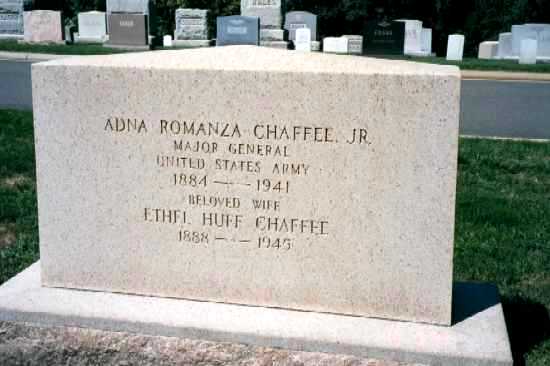Adapted from the Department of Military Instruction Homepage, USMA
Adna Romanza Chaffee Jr.
23 September 1884 –22 August 1941
Cullum No.4483 Class of 1906
Born in Junction City, Kansas on 23 September 1884, Adna Chaffe was the only son of a distinguished soldier, Adna Romanza Chaffee, Sr., who would rise to the rank of Major General. Major General Chaffee graduated from West Point in 1906, 31st in his class of 78 graduates.
Commissioned a Cavalry Lieutenant, his first tour of duty was with the 15th Cavalry as part of the Army of Cuban Pacification. An extremely competent horseman, he next was assigned to theMounted Services School at Fort Riley, Kansas from 1907-1911, where he commanded the mounted detachment serving the students and staff of the Army War College. He was also a member of American Equestrian Teams that competed world-wide. Chaffee then attended the French Cavalry School at Saumur for a year, returning to teach again at Fort Riley.
Chaffee’s next posting was with the 7th Cavalry in the Philippines (1914-1915). He was then reassigned to the Staff and Faculty at West Point as the Senior Cavalry Instructor in the Tactical Department (1916-1917). Now a Captain, Chaffee next served as the adjutant for the 81st Division as it prepared to depart for France in WW I. During the war he served as an Assistant G3 Operations officer in the IV Corps and then as the G3 of the 81st Division during the St. Mihiel and Meu se-Argonne offensives. Promoted to the temporary rank of Colonel, he became the G3, III Corps for the duration of the war and remained with the corps for occupation duty in 1919.
Colonel Chaffee returned to the United States in 1919 as an instructor at the Command and General Staff School at Fort Leavenworth. In 1920 he attained the permanent rank of Major, having reverted to his permanent rank of Captain after the war. Chaffee held a variety of positions with the 3rd Cavalry and IVth Corps after his tour at Fort Leavenworth. He became the G3 for the 1st Cavalry Division in 1921 and remained at Fort Bliss through 1924. After attending the Army War College, he assumed command of a squadron of the 3rd Cavalry from 1925 to 1927. Following this command, he moved to the War Department’s General Staff (1927-1931), was promoted to Lieutenant Colonel and worked on developing mechanized and armored forces for the Army. Chaffee left the General Staff in 1931 to serve as the Executive Officer of the newly formed 1st Cavalry (Mechanized) at Fort Knox.
Returning to Washington, D.C. and the War Department in 1934, Chaffee served as the Chief of the Budget and Legislative Planning Branch (1934-1938) and returned to Fort Knox in 1938 to assume command of the 1st Cavalry (Mech). He was promoted to Brigadier General in November 1938 and given the command of the 7th Mechanized Brigade. He led the embryonic unit through crucial maneuvers conducted in Plattsburgh and Louisiana (1939-1940). The Louisiana Maneuvers in particular are noteworthy for the impact they had on developing U.S. mechanized doctrine.
In June 1940, Brigadier General Chaffee was appointed the Commander of the Armored Force, responsible for integrating all branches of the Army into mechanized warfare As such he played a major role in the development and fielding of the 1st and 2nd Armored Divisions. Promoted to Major General in October 1940, he was given command of the I Armored Corps. Unfortunately, before many of the major armored battles of World War II that changed the face of modern warfare forever.
Major General Chaffee died of cancer on 22 August 1941 in Boston, Massachusetts. Nonetheless, General Chaffee is still considered the father of the Armor branch. He is buried next to his father in Section 3 of Arlington National Cemetery.
CHAFFEE, ADNA R
MAJOR GEN US ARMY
- DATE OF DEATH: 08/22/1941
- BURIED AT: SECTION 3 SOU SITE 1944
- ARLINGTON NATIONAL CEMETERY
Michael Robert Patterson was born in Arlington and is the son of a former officer of the US Army. So it was no wonder that sooner or later his interests drew him to American history and especially to American military history. Many of his articles can be found on renowned portals like the New York Times, Washingtonpost or Wikipedia.
Reviewed by: Michael Howard

